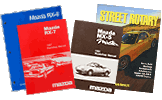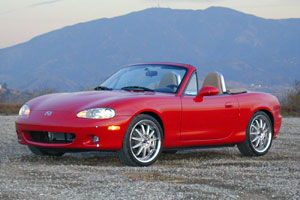
The Top 5 Best-Bang-For-The-Buck Performance Upgrades For Your Miata
The one question we hear all the time is "What product can I install that will give me the best performance upgrade for my Miata?" Of course you can install a turbocharger or supercharger system or convert your engine to a V-8, but most people that have just purchased their first Miata or are looking to start their upgrade project usually are interested the more affordable bolt-on products available from the aftermarket. What REALLY works? Is it worth the price? Follow along and will give you our favorite Top 5 Products that really work for the Miata.
#1. Tires
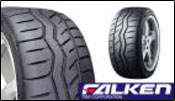
Yep, tires. You'll be amazed at the performance potential of a good set of high performance tires. The selection can be rather mind-numbing, but spend some time around the forums, autocross tracks, club meets, and you'll soon get a feeling for the brands, models and sizes of tires that work best on the Miata. Don't expect your local tire store, discount warehouse, chain-store outlet, etc.. to know the specific handling and wear qualities of their tires with regards to the Miata, keep in mind that their job is to sell tires to every mom-and-pop that drives in with their SUV or family sedan. Go to the real experts, other Miata owners!
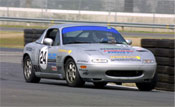
When making a tire selection also consider some of the smaller companies such as Falken and Kumho, they produce some outstanding performance tires at very competitive prices. Select a tire that is suitable for use for your local road conditions and weather conditions. A high performance tire that could be used year-around in Southern California (minimal rain, no snow, good road conditions), would not be suitable for use in other parts of the country during the harsh winter months. Higher performing tires tend to have stiffer side walls, which will produce a harsher ride quality in areas with poor road conditions.
Tire wear, road noise, and ride comfort are serious issues to consider when making your choice of tires. Many high performance and ultra high performance tires obtain their tremendous gripping characteristics from softer rubber compounds, which do not last as long as higher mileage passenger car tires. Check the tread wear rating that is displayed on the side wall of each tire - lower values (100-200 range) will typically wear much faster than touring tires (200-300+). Tires with ratings below 100 will typically offer the greatest handling potential, but wear very quickly, tend to produce more road noise, and may produce a harsher ride. Aggressive alignment settings (increased negative camber, toe, etc..) will further improve handling, but accelerated tire wear is a side effect of these benefits.
The selection of a tire is a very subjective topic, there is no "one" perfect tire for everyone. Tires tend to be an expensive purchase and a poor selection means you're stuck with them for 1-2 years. Make the right selection and you'll enjoy a significant handling performance improvement with your Miata!
#2. Air Intake

Finding additional power increases from the Miata is difficult, but not impossible. One of the easiest and most cost effective methods to increase power and throttle response is by installing a higher flowing, less restrictive air intake system.
A bit of background information at this point is helpful. If you've heard the sound of an "open" intake you know that the sound can be surprisingly loud. Auto manufacturers go to extensive lengths to subdue this noise on their passenger cars. Elaborate intake tubes, sound suppression ducts, filter housing boxes, and small diameter inlet openings are incorporated into the design to quiet the noise. The downside is that these designs can sacrifice power and throttle response in their quest to keep things to a reasonable level.
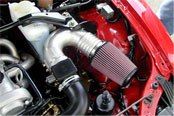
An aftermarket intake system removes the restrictive air box and inlet tube, and replaces them with a larger diameter inlet tube and low restriction paper or foam air filter. If possible, the air filter element should be located in an area of the engine compartment that allows the engine to draw in "cooler" external ambient air. On the early 1990-97 Miata chassis this was difficult due to the design of the engine compartment, while the later 1999-2005 Miata chassis offered more inlet air possibilities. Over the years we've seen countless numbers of "cold air" inlet ducts, ranging from crude clothes dryer ducting to more advanced molded-plastic duct kits. They all seem to work to some degree, some better than others.
Our extensive testing of these systems over the years have all yielded the same approximate results, the vast majority of these systems produce a 5-6 HP gain. Power gains typically begin in mid-range of the power band and increase steadily across the power curve. Throttle response is much improved after the installation of an intake, the Miata engine seems to respond quicker to throttle inputs with the lower restriction system and larger diameter inlet tube.
Sound levels will be notably louder than stock, which may take a bit of driver adjustment after installation. The vast majority of Miata owners like the intake "roar" under full throttle acceleration, but some may feel it is too loud. Under steady cruising speeds the intake sound moderates and simply blends in with the usual Miata road noise.
An air intake kit is an emissions sensitive device and may impact the emissions status of your Miata. If your state requires tailpipe smog testing, any non-compliant intake kit may prevent you from passing the emissions test. For a more comprehensive review of this subject, read this article. All 1990-97 Miata intakes offered by Racing Beat are CA emissions compliant and have received an emissions exemption by CARB.
Most kits are easy to install (approx 1 hour), can be accessed from the top of the engine compartment, and require only simple hand tools.
#3. Sway Bar Set
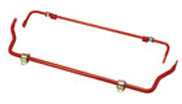
While the handling capabilities of your Miata are quite remarkable, upgrading the various suspension components can dramatically improve the handling qualities. One of the easiest and most economical ways to noticeable improve the handling of your Miata, without increasing ride harshness, is by upgrading your sway bar set. Reducing the body roll of your Miata allows for increased traction and improved weight transfer. Sway bars are usually designed as a front and rear matched-set by the manufacturer for each specific application. Unless you are familiar with suspension set-up or are attempting to custom tune your car for a race application, we strongly recommend you purchase a matched set!
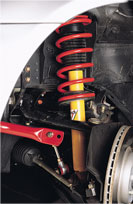
With all of the various bars available on the market, what exactly is "best" for your application? For every-day street use, a 7/8" OD solid front bar and 5/8" OD rear bar have been used successfully for many years and have become "standards" for the 1990-97 Miata application. If you are trying to alter the handling of your car to suit your particular driving style, tire selection, racing applications, etc.. there are larger, stiffer, tubular front sway bars available for this purpose. Here is link to an article written by a noted SOLO II racer regarding his sway bar findings for racing applications.
Another popular upgrade that many Miata owners undertake during a sway bar upgrade is the replacement of the sway bar endlinks. The endlinks connect the sway bar to the lower control arm and move vertically with the movement of the suspension. Many stock endlinks contain soft, vibration dampening rubber bushing components that are intended to soften harsh steering feedback, but by design they also isolate some amount of "road feel." Replacing the old, tired stock units with a set of performance-based links will provide more immediate steering feedback to the driver.
This project can be easily undertaken in 2-3 hours and only requires simple hand tools, a floor jack, and support stands.
#4. Exhaust Header
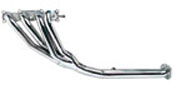
Offering similar performance upgrades as the air intake kit, an exhaust header upgrade on all 1990-2005 Miatas (non-turbo) offers a noticeable power gain. Although the Miata was originally equipped with an exhaust manifold that resembled a traditional "header" design, we've found areas of improvement with an aftermarket unit.
Header design will vary greatly from manufacturer-to-manufacturer, but we've found that most produce similar power gains. Racing Beat has undertaken extensive testing over the years in an effort to maximize the power output of our header as compared to other available units. Typically power gains are realized beginning in the 3000 RPM range, extending up the 6500-7000 limit.
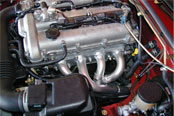
Header installation on the 1990-1997 Miata is a modest undertaking and can be completed by a Miata enthusiast with a well-stocked tool box of common wrenches, sockets, etc.. You'll need to access the car from both the engine compartment and from under the center of the vehicle, so a floor jack and stands are required. The normal installation effort should take 2-4 hours.
An engine header is an emissions sensitive device and may impact the emissions status of your Miata. If your state requires tailpipe smog testing an non-compliant intake kit may prevent you from successfully completing the test. For a more comprehensive review of this subject, read this article.
#5. Aluminum Flywheel
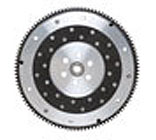
One of the greatest joys of driving a Miata is the ability to race through the gear box with relative ease. If you thought it was fun before, just wait until you install an aluminum flywheel! Yes, the installation effort is considerable, but if you are replacing a worn out clutch disc on a high mileage Miata this is the perfect time to consider an upgrade to this little gem.
By definition, a flywheel is a mechanical device with significant "moment of inertia" that stores rotational energy produced by the engine. Flywheels resist changes in their rotational speed, heavier flywheels consume more power to rotate them up to speed, while lighter units consume less power. Car manufacturers prefer slightly heavier flywheel units to allow ease of clutch engagement and to avoid "stalling" the vehicle.
Performance flywheels are typically lighter versions of the stock components, significantly reducing the moment of inertia that is required to rotate the the flywheel, allowing the engine to more efficiently utilize the available power. A common misconception is to think that installing a lighter flywheel will "increase" horsepower, this is not the case. It may seem as though you've increased the power output due to the improved revving capabilities of the engine, you've simply regained power that was being consumed by the heavier flywheel.
OK, so now that we understand the physics behind the a lightweight flywheel, why consider it as a Top 5 improvement? Simply put, its fun! Your engine RPM's will rise and fall much quicker than before, improving gear selection and shifting speed. Combine this with the already outstanding short-throw Miata transmission and you'll be searching for the next twisty bit of road in your area!
Engaging a lighter flywheel and performance clutch combination will require a bit more refinement of your engagement technique. Yes, you'll probably stall the car a handful of times during the first week of driving, but once you adjust your technique to bring up the RPM slightly and more quickly engage the clutch, you'll be off and running. By week two you'll be wondering why you didn't undertake this upgrade sooner!

